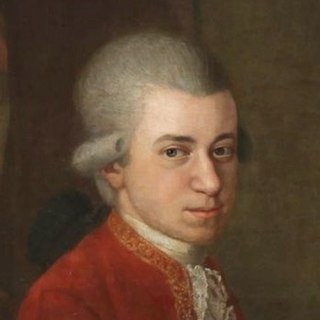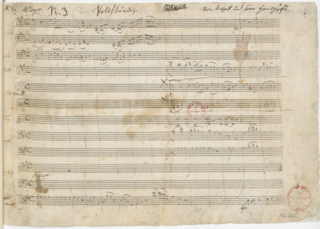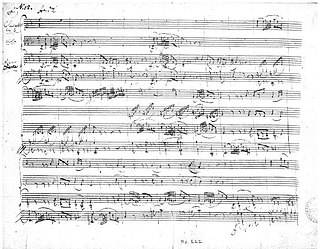Related Research Articles

Isaac Stern was an American violinist.
A piano trio is a group of piano and two other instruments, usually a violin and a cello, or a piece of music written for such a group. It is one of the most common forms found in classical chamber music. The term can also refer to a group of musicians who regularly play this repertoire together; for a number of well-known piano trios, see below.

Eine kleine Nachtmusik, K. 525, is a 1787 composition for a chamber ensemble by Wolfgang Amadeus Mozart (1756–1791). The German title means "a little night music". The work is written for an ensemble of two violins, viola, cello and double bass, but is often performed by string orchestras. The serenade is one of Mozart's most famous works.

Symphony No. 40 in G minor, K. 550 was written by Wolfgang Amadeus Mozart in 1788. It is sometimes referred to as the "Great G minor symphony", to distinguish it from the "Little G minor symphony", No. 25. The two are the only extant minor key symphonies Mozart wrote.

Symphony No. 35 in D major, K. 385, also known as the Haffner Symphony, was composed by Wolfgang Amadeus Mozart in 1782. It was commissioned by the Haffners, a prominent Salzburg family, for the occasion of the ennoblement of Sigmund Haffner the Younger. The Haffner Symphony should not be confused with the eight-movement Haffner Serenade, another piece Mozart wrote on commission from the same family in 1776.
G major is a major scale based on G, with the pitches G, A, B, C, D, E, and F♯. Its key signature has one sharp. Its relative minor is E minor and its parallel minor is G minor.

The Piano Concerto No. 23 in A major K. 488 is a concerto for piano and orchestra written by Wolfgang Amadeus Mozart. It was finished, according to Mozart's own catalogue, on March 2, 1786, two months prior to the premiere of his opera, Le nozze di Figaro, and some three weeks prior to the completion of his next piano concerto. It was one of three subscription concerts given that spring and was probably played by Mozart himself at one of these.

Joseph Leopold Eybler was an Austrian composer and contemporary of Wolfgang Amadeus Mozart.

The Kegelstatt Trio, K. 498, is a piano trio for clarinet, viola and piano in E-flat major by Wolfgang Amadeus Mozart.

Anton Franz Josef Eberl {pronounced EH-BERL} was an Austrian composer, teacher and pianist of the Classical period. He was a student of Salieri and Mozart. He was also seen as an early friend and rival of Beethoven.

A clarinet–viola–piano trio, often titled "Trio for Clarinet, Viola and Piano" is a work of chamber music that is scored for clarinet, viola, and piano; or is the designation for a musical ensemble of a group of three musicians playing these instruments. This combination of instruments differs from other combinations, as the viola and the clarinet share approximately the same musical range, but not the same tone quality.

Mozart's Piano Quartet No. 2 in E-flat major, K. 493, was written after Franz Anton Hoffmeister released Mozart from the obligation of writing three piano quartets.
Wolfgang Amadeus Mozart composed six sonatas for keyboard with accompaniment of violin and cello, K. 10–15, in late 1764 in London during the Mozart family's grand tour of Europe. Queen Charlotte commissioned them on 25 October, and the works were dedicated to her on 18 January 1765. They were published as Mozart's "Opus III" by his father Leopold at 20 Frith Street, Soho, London, where the Mozarts lived from September 1764 until after May 1765.
The Trio for piano, flute and bassoon in G major, WoO. 37 is a composition for piano trio by Ludwig van Beethoven that was discovered amongst Beethoven's papers following his death. Believed to have been composed in his teens and demonstrating the influence of Mozart, the composition remained unpublished until 1888, when it was published in the supplement to the complete set of the composers works by Breitkopf & Härtel.
The Piano Trio No. 1 in B-flat major (Divertimento), K. 254, was written by Wolfgang Amadeus Mozart in 1776. It is scored for piano, violin and cello.
The Piano Trio No. 3 in B-flat major, K. 502, was written by Wolfgang Amadeus Mozart in 1786. It is scored for piano, violin and cello.
The Piano Trio No. 4 in E major, K. 542, was written by Wolfgang Amadeus Mozart in 1788. It is scored for piano, violin and cello. It's the only multi-movement composition by Mozart in the key of E major.
The Piano Trio No. 5 in C major, K. 548, was written by Wolfgang Amadeus Mozart in July 1788. It is scored for piano, violin and cello.
The Piano Trio No. 6 in G major, K. 564, was written by Wolfgang Amadeus Mozart in 1788 and is part of his series of piano trios. It is scored for piano, violin and cello.
References
- ↑ Herttrich, Ernst (2005). Mozart Piano Trios - Preface. Munich: G. Henle Verlag.
- ↑ "Series VIII: Chamber Music". Neue Mozart-Ausgabe . Retrieved 18 December 2020.